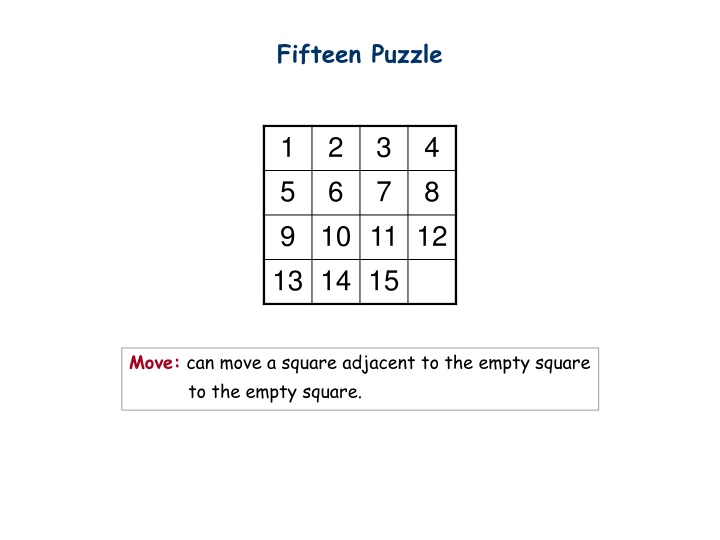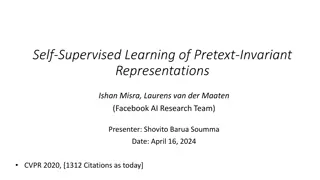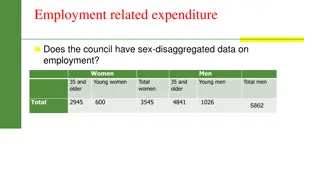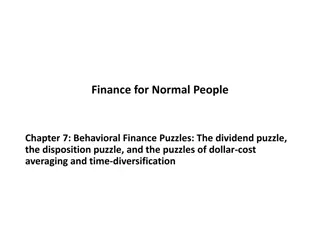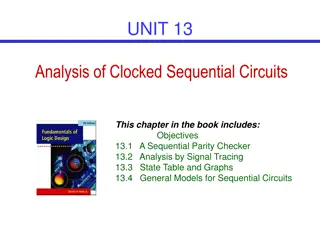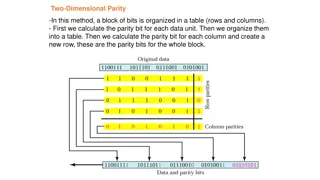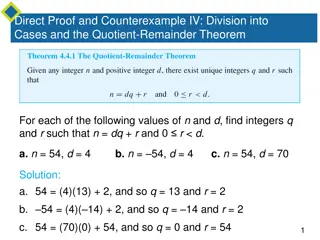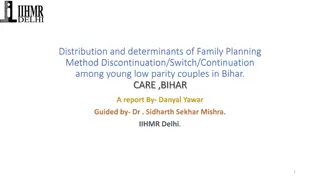Fifteen Puzzle Invariant Method: Understanding Parity in Solvability
Delve into the intricacies of the Fifteen Puzzle using the Invariant Method to analyze the solvability based on the concept of parity. Explore how the parity of states remains unchanged through moves, leading to the conclusion of solvability impossibility.
Download Presentation

Please find below an Image/Link to download the presentation.
The content on the website is provided AS IS for your information and personal use only. It may not be sold, licensed, or shared on other websites without obtaining consent from the author.If you encounter any issues during the download, it is possible that the publisher has removed the file from their server.
You are allowed to download the files provided on this website for personal or commercial use, subject to the condition that they are used lawfully. All files are the property of their respective owners.
The content on the website is provided AS IS for your information and personal use only. It may not be sold, licensed, or shared on other websites without obtaining consent from the author.
E N D
Presentation Transcript
Fifteen Puzzle 1 5 9 10 11 12 13 14 15 2 6 3 7 4 8 Move: can move a square adjacent to the empty square to the empty square.
Fifteen Puzzle 1 5 9 10 11 12 13 14 15 2 6 3 7 4 8 1 5 9 10 11 12 13 15 14 2 6 3 7 4 8 Target configuration Initial configuration Is there a sequence of moves that allows you to start from the initial configuration to the target configuration?
Invariant Method 1. Find properties (the invariants) that are satisfied throughout the whole process. 2. Show that the target do not satisfy the properties. 3. Conclude that the target is not achievable. What is an invariant in this game?? This is usually the hardest part of the proof.
Hint 1 5 9 10 11 12 13 14 15 2 6 3 7 4 8 1 5 9 10 11 12 13 15 14 2 6 3 7 4 8 Target configuration Initial configuration ((1,2,3, ,15,14),(4,4)) ((1,2,3, ,14,15),(4,4)) Hint: the two states have different parity.
Parity Given a sequence, a pair is out-of-order if the first element is larger. More formally, given a sequence (a1,a2, ,an), a pair (i,j) is out-of-order if i<j but ai> aj. For example, the sequence (1,2,4,5,3) has two out-of-order pairs, (4,3) and (5,3). Given a state S = ((a1,a2, ,a15),(i,j)) Parity of S = (number of out-of-order pairs + row) mod 2 row number of the empty square
Hint 1 5 9 10 11 12 13 14 15 2 6 3 7 4 8 1 5 9 10 11 12 13 15 14 2 6 3 7 4 8 Target configuration Initial configuration ((1,2,3, ,15,14),(4,4)) ((1,2,3, ,14,15),(4,4)) Parity of S = (number of out-of-order pairs + row) mod 2 Clearly, the two states have different parity.
Invariant Method Parity is even 1. Find properties (the invariants) that are satisfied throughout the whole process. 2. Show that the target do not satisfy the properties. 3. Conclude that the target is not achievable. Parity is odd Invariant = parity of state Claim: Any move will preserve the parity of the state. Proving the claim will finish the impossibility proof.
Proving the Invariant Parity of S = (number of out-of-order pairs + row) mod 2 Claim: Any move will preserve the parity of the state. ? ? ? ? ? a ? ? ? ? ? ? ? ? ? ? ? ? ? a ? ? ? ? ? ? ? ? ? ? Horizontal movement does not change anything
Proving the Invariant Parity of S = (number of out-of-order pairs + row) mod 2 Claim: Any move will preserve the parity of the state. ? ? ? a b1 b2 ? ? ? ? ? ? ? ? ? ? b1 b2 ? ? b3 ? ? ? b3 a ? ? ? Row number has changed by 1 ? To count the change on the number of out-of-order pairs, we can distinguish 4 cases, depending on the relative order of a among (a,b1,b2,b3).
Proving the Invariant Parity of S = (number of out-of-order pairs + row) mod 2 Claim: Any move will preserve the parity of the state. ? ? ? a b1 b2 ? ? ? ? ? ? ? ? ? ? b1 b2 ? ? b3 ? ? ? b3 a ? ? ? Row number has changed by 1 ? Case 1: when a is largest, then the number of out-of-order pairs will decrease by three, and since the row number is changed by one, the parity is still the same.
Proving the Invariant Parity of S = (number of out-of-order pairs + row) mod 2 Claim: Any move will preserve the parity of the state. ? ? ? a b1 b2 ? ? ? ? ? ? ? ? ? ? b1 b2 ? ? b3 ? ? ? b3 a ? ? ? Row number has changed by 1 ? Case 2: when a is the second largest, then the number of out-of-order pairs will decrease by one, and since the row number is changed by one, the parity is still the same. (The remaining case analysis is the same.)
Proving the Invariant Parity of S = (number of out-of-order pairs + row) mod 2 Claim: Any move will preserve the parity of the state. ? ? ? a b1 b2 ? ? ? ? ? ? ? ? ? ? b1 b2 ? ? b3 ? ? ? b3 a ? ? ? Row number has changed by 1 ? Difference is 1 or 3. If there are (0,1,2,3) out-of-order pairs in the current state, there will be (3,2,1,0) out-of-order pairs in the next state. So the parity stays the same! We ve proved the claim.
Fifteen Puzzle 1 5 9 10 11 12 13 14 15 2 6 3 7 4 8 15 14 13 12 11 10 9 7 6 3 2 8 4 5 1 Target configuration Initial configuration Is there a sequence of moves that allows you to start from the initial configuration to the target configuration?
Fifteen Puzzle 1 5 9 10 11 12 13 14 15 2 6 3 7 4 8 15 14 13 12 11 10 9 7 6 3 2 8 4 5 1 Target configuration Initial configuration Number of out-of-order pairs = 0 Number of out-of-order pairs = 14 + 13 + 12 + + 1 = 14(13)/2 = 91 Row of empty square = 4 Parity is even. Row of empty square = 4 Parity is odd. Impossible!
Fifteen Puzzle If two configurations have the same parity, is it true that we can always move from one to another?
K=4 x=0 Remember the checker game that we have seen before?
K=5 This can also be solved by the invariant method. Sorry there are no slides for this proof. The proof can be found in Mathematical Gems II by Honsberger. There are three books on Mathematical Gems and all are excellent.
Covering with Trominoes Can you cover a 8X8 board with straight trominoes? No, since the board has 64 squares and each tromino covers 3. So, lets remove one corner so that the board now has 63 squares. Can we now, cover with straight trominoes?
Lets try our coloring trick. Color board so that each tromino colors 3 different colors Of the 4 corners, say 2 are red and one each are blue, yellow Rotate board so that missing corner is blue/ yellow Now we have 22 reds, 21 yellows and 20 blues!!
Set Theory A B C
Basic Definitions Operations on Sets Set Identities Russell s Paradox
Defining Sets Definition: A set is an unordered collection of objects. The objects in a set are called the elements or members of the set S, and we say S contains its elements. We can define a set by directly listing all its elements. e.g. S = {2, 3, 5, 7, 11, 13, 17, 19}, S = {CSC1130, CSC2110, ERG2020, MAT2510} After we define a set, the set is a single mathematical object, and it can be an element of another set. e.g. S = {{1,2}, {1,3}, {1,4}, {2,3}, {2,4}, {3,4}}
Defining Sets by Properties It is inconvenient, and sometimes impossible, to define a set by listing all its elements. Alternatively, we can define by a set by describing the properties that its elements should satisfy. { | ( ) } x A P x We use the notation to define the set as the set of elements, x, in A such that x satisfies property P. e.g.
Examples of Sets Well known sets: the set of all real numbers, the set of all complex numbers, the set of all integers, the set of all positive integers empty set, , the set with no elements. Other examples: The set of all polynomials with degree at most three: {1, x, x2, x3, 2x+3x2, }. The set of all n-bit strings: {000 0, 000 1, , 111 1} The set of all triangles without an obtuse angle: { , , } The set of all graphs with four nodes: { , , , , }
Membership Order, number of occurence are not important. e.g. {a,b,c} = {c,b,a} = {a,a,b,c,b} The most basic question in set theory is whether an element is in a set. x is not an element of A x is not in A x is an element of A x is in A 7 2/3 e.g. Recall that Z is the set of all integers. So and . Let P be the set of all prime numbers. Then and Let Q be the set of all rational numbers. Then and (will prove later)
Size of a Set In this course we mostly focus on finite sets. Definition: The size of a set S, denoted by |S|, is defined as the number of elements contained in S. e.g. if S = {2, 3, 5, 7, 11, 13, 17, 19}, then |S|=8. if S = {CSC1130, CSC2110, ERG2020, MAT2510}, then |S|=4. if S = {{1,2}, {1,3}, {1,4}, {2,3}, {2,4}, {3,4}}, then |S|=6. Later we will study how to determine the size of the following sets: the set of poker hands which are full house . the set of n-bit strings without three consecutive ones. the set of valid ways to add n pairs of parentheses
Subset Definition: Given two sets A and B, we say A is a subset of B, denoted by , if every element of A is also an element of B. B A not a subset If A={4, 8, 12, 16} and B={2, 4, 6, 8, 10, 12, 14, 16}, then but because every element in A is an element of A. for any A because the empty set has no elements. If A is the set of prime numbers and B is the set of odd numbers, then Fact: If , then |A| <= |B|.
Proper Subset, Equality Definition: Given two sets A and B, we say A is a proper subset of B, denoted by , if every element of A is an element of B, But there is an element in B that is not contained in A. Fact: If , then |A| < |B|. B A Definition: Given two sets A and B, we say A = B if and . B A Fact: If A = B, then |A| = |B|.
Exercises 1. ? 2. {3} {5,7,3}? 3. every set? 4. {1,2} {{1,2}, {2,3}, {3,1}}? 5. {a} = {{a}}? 6. If A B and B C, then A C? 7. If A B and B C, then A C?
This Lecture Basic Definitions Operations on Sets Set Identities Russell s Paradox
Basic Operations on Sets Let A, B be two subsets of a universal set U (depending on the context U could be R, Z, or other sets). intersection: Defintion: Two sets are said to be disjoint if their intersection is an empty set. e.g. Let A be the set of odd numbers, and B be the set of even numbers. Then A and B are disjoint. union: Fact:
Basic Operations on Sets difference: Fact: complement: e.g. Let U = Z and A be the set of odd numbers. Then is the set of even numbers. Fact: If , then
Examples A = {1, 3, 6, 8, 10} B = {2, 4, 6, 7, 10} A B = {6, 10}, A B = {1, 2, 3, 4, 6, 7, 8, 10} A-B = {1, 3, 8} Let U = { x Z | 1 <= x <= 100}. A = { x U | x is divisible by 3}, B = { x U | x is divisible by 5} A B = { x U | x is divisible by 15} A B = { x U | x is divisible by 3 or is divisible by 5 (or both)} A B = { x U | x is divisible by 3 but is not divisible by 5 } Exercise: compute |A|, |B|, |A B|, |A B|, |A B|.
Partitions of Sets Two sets are disjoint if their intersection is empty. A collection of nonempty sets {A1, A2, , An} is a partition of a set A if and only if A1, A2, , Anare mutually disjoint (or pairwise disjoint). e.g. Let A be the set of integers. Let A1be the set of negative integers. Let A2be the set of positive integers. Then {A1, A2} is not a partition of A, because A A1 as 0 is contained in A but not contained in A1 A2 A2
Partitions of Sets e.g. Let A be the set of integers divisible by 6. A1be the set of integers divisible by 2. A2be the set of integers divisible by 3. Then {A1, A2} is not a partition of A, because A1and A2are not disjoint, and also A A1 A2(so both conditions are not satisfied). e.g. Let A be the set of integers. A1= {x A | x = 3k+1 for some integer k} A2= {x A | x = 3k+2 for some integer k} A3= {x A | x = 3k for some integer k} Then {A1, A2,A3} is a partition of A
Power Sets = ( ):: { | p w A o } S S A power set: In words, the power set pow(A) of a set A contains all the subsets of A as members. pow({a,b}) = { , {a}, {b}, {a,b}} pow({a,b,c}) = { , {a}, {b}, {c}, {a,b}, {a,c}, {b,c}, {a,b,c}} pow({a,b,c,d}) = { , {a}, {b}, {c}, {d}, {a,b}, {a,c}, {b,c}, {a,d}, {b,d}, {c,d}, {a,b,c}, {a,b,d}, {a,c,d}, {b,c,d}, {a,b,c,d}} Fact (to be explained later): If A has n elements, then pow(A) has 2nelements.
Cartesian Products Definition: Given two sets A and B, the Cartesian product A x B is the set of all ordered pairs (a,b), where a is in A and b is in B. Formally, Ordered pairs means the ordering is important, e.g. (1,2) (2,1) e.g. Let A be the set of letters, i.e. {a,b,c, ,x,y,z}. Let B be the set of digits, i.e. {0,1, ,9}. AxA is just the set of strings with two letters. BxB is just the set of strings with two digits. AxB is the set of strings where the first character is a letter and the second character is a digit.
Cartesian Products The definition can be generalized to any number of sets, e.g. Using the above examples, AxAxA is the set of strings with three letters. An ID card number has one letter and then six digits, so the set of ID card numbers is the set AxBxBxBxBxBxB. Fact: If |A| = n and |B| = m, then |AxB| = mn. Fact: If |A| = n and |B| = m and |C| = l, then |AxBxC| = mnl. Fact: |A1xA2x xAk| = |A1|x|A2|x x|Ak|.
Exercises 1. Let A be the set of prime numbers, and let B be the set of even numbers. What is A B and |A B|? 2. Is |A B| > |A| > |A B| always true? 3. Let A be the set of all n-bit binary strings, Aibe the set of all n-bit binary strings with i ones. Is (A1, A2, , Ai, , An) a partition of A? 4. Let A = {x,y}. What is pow(A)xpow(A) and |pow(A)xpow(A)|?
